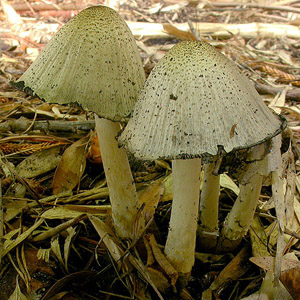
images/Coprinopsis/Coprinopsis_atramentarius_TM_DSCN8928_edit_a.jpg
Small to large agaric, growing on the ground, litter or mulch, wood or dung, or among vertebrate animal carcasses, with a dark brown, purple-brown or black spore print. Pileus white, pale, brown, grey or black, sometimes with scales or patches from universal veil, not viscid. Lamellae adnexed or adnate. Stipe central. Partial veil remnants a ring zone or absent. Fruit-body deliquescent. Spores reddish brown, brown or black, smooth, rarely warty; germ pore broad or rarely narrow. Cheilocystidia present; pleurocystidia usually present. Lamellar trama regular or interwoven with age. Pileipellis a cutis (can be misinterpreted as an epithelium from overlying veil remnants); pileocystidia absent. Clamp connections present or absent.
This genus is rather similar to
Coprinellus, but it has a hymeniderm or epithelioid pileipellis (often with pileocystidia), whereas the pileipellis of
Coprinopsis is a cutis (although there is usually a veil present, which can have cylindrical or globose elements). The universal veil can leave distinct remnants on the pileus surface (as in the scales of
C. stangliana) or not. Members of
Coprinus in the strict sense have an annulus and lack pleurocystidia; the few species of
Coprinopsis with a ring zone (e.g.
C. atramentaria) can be separated from
Coprinus by the presence of a universal veil. However, this can be filamentous and difficult to distinguish from the underlying pileipellis. There is no universal veil in
Parasola, the fruit-body is collapsing (rather than truly deliquescent) and the pileus is always strongly plicate. Other genera with a black spore print and a hymeniderm or epithelioid pileipellis (such as
Panaeolus and
Psathyrella) are not deliquescent.
Coprinopsis P.Karst., Acta Soc. Fauna Fl. Fenn. 2: 27 (1881).
Rhacophyllus Berk. & Broome.
About a dozen species reported, further species expected:
Coprinopsis atramentaria,
C. austrophlyctidospora (=
C. phlyctidospora in the sense of Australian records),
C. cinerea,
C. clastophylla (known only from the form known as
Rhacophyllus lilacinus where the lamellae are replaced by tiny, pink sacs, which in turn contain angular, asexual spores),
C. herbivora,
C. lagopus,
C. macrocephala,
C. nivea,
C. radiata,
C. stangliana,
C. stercorea (=
Coprinus stercorarius),
C. tuberosa (=
Coprinopsis sclerotiger, =
Coprinus stercorarius sensu Walker & Moore) and
C. vermiculifer.
W.A., S.A., Qld, N.S.W., Vic. and Tas. (and probably also N.T.).
In native forests, farmlands, parks and gardens.
On the ground, litter and mulch, wood (including buried dead wood) or dung. Sometimes around vertebrate animal remains or where nitrogen sources (such as urea) have been applied.
Saprotrophic.
Barrett, M. (2006),
Rhacophyllus lilacinus in the Kimberley region of WA,
Fungimap Newslett. 28: 5. [
Illustration of
C. clastophylla (as
Rhacophyllus lilacinus)]
Bougher, N.L. (1983), Western Australian Coprinus as part of a cosmopolitan flora, Trans. Brit. Mycol. Soc. 81: 147–149. [Reports several cosmopolitan species of Coprinopsis (as Coprinus) on horse and kangaroo dung from Western Australia]
Bougher, N. (2006), Copriniopsis stangliana - a recently introduced fungus expanding in urban bushlands of the Perth region of Western Australia, Nuytsia 16: 3–10. [B&W Illustration, Description and Microcharacters of C. stangliana]
Bougher, N.L. (2009a), Fungi of the Perth region and beyond: a self-managed field book, Western Australian Naturalists' Club (Inc.), Perth. [Description and Illustration of C. lagopus and C. aff. stangliana]
Breitenbach, J. & Kränzlin, F. (eds) (1995), Fungi of Switzerland. Volume 4. Agarics 2nd part. Edition Mykologia, Lucerne. [Illustration, Description and Microcharacters of C. atramentaria, C. macrocephala, C. nivea and C. stercorea]
Fuhrer, B. (2005), A Field Guide to Australian Fungi. Bloomings Books, Hawthorn. [Description and Illustration of C. atramentaria (as Coprinus) and Coprinopsis nivea]
Fukiharu, T., Bougher, N.L., Buchanan, P.K., Suzuki, A., Tanaka, C. & Sagara, N. (2011), Coprinopsis austrophlyctidospora sp. nov., an agaric ammonia fungus from southern hemisphere plantations and natural forests, Mycoscience 52: 137–142. [Illustration, Description and Microcharacters for C. austrophlyctidospora]
Grgurinovic, C.A. (1997a), Larger Fungi of South Australia. The Botanic Gardens of Adelaide and State Herbarium and The Flora and Fauna of South Australia Handbooks Committee, Adelaide. [Description, Illustration and Microcharacters of C. nivea ( as Coprinus), and Key to South Australian species of Coprinus in a broad sense]
McCann, I.R. (2003), Australian Fungi Illustrated. Macdown Productions, Vermont. [Illustration of C. atramentaria and C. nivea, both as Coprinus]
Orton, P.D. & Watling, R. (1979), British Fungus Flora. Agarics and Boleti. 2 / Coprinaceae Part 1: Coprinus. Royal Botanic Garden, Edinburgh. [Description and Microcharacters of C. atramentaria, C. macrocephala, C. nivea, C. stercorea, C. tuberosa (as C. sclerotiger) and C. vermiculifer, and B&W Illustration of some of these species, along with Key to British species, all as Coprinus]
Walker, J. & Moore, K. (1974), Coprinus stercorarius as an industrial contaminant, Trans. Brit. Mycol. Soc. 63: 449–455. [Description, B&W Illustration and Microcharacters of C. tuberosa (as Coprinus stercorarius) [our re-identification, due to large spores and presence of sclerotium]
Young, A.M. (2005b), A Field Guide to the Fungi of Australia. University of New South Wales Press, Sydney. [Description and B&W Illustration of C. atramentaria (as Coprinus)]


_AI_26_sml.jpg)
